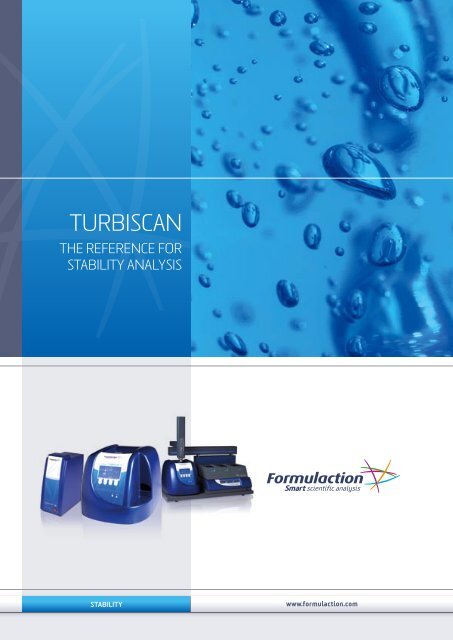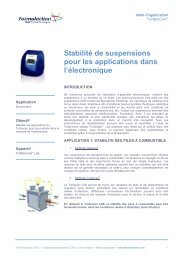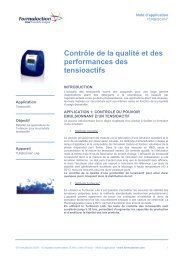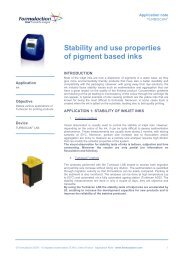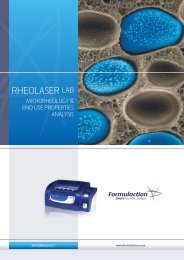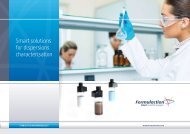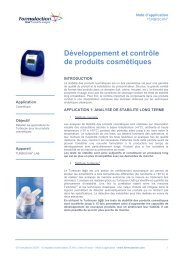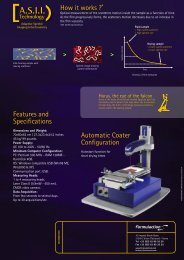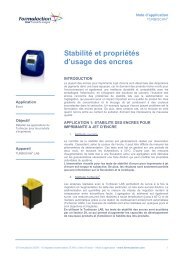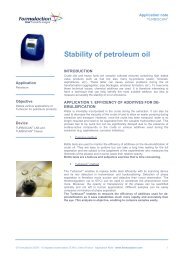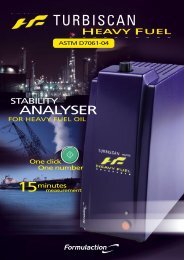Doc technik.pdf - Formulaction
Doc technik.pdf - Formulaction
Doc technik.pdf - Formulaction
You also want an ePaper? Increase the reach of your titles
YUMPU automatically turns print PDFs into web optimized ePapers that Google loves.
TURBISCAN<br />
THE REFERENCE FOR<br />
STABILITY ANALYSIS<br />
STABILITY<br />
www.formulaction.com
TURBISCAN<br />
THE REFERENCE<br />
FOR STABILITY ANALYSIS<br />
The Turbiscan range is world widely used in order to<br />
characterize the dispersion state of emulsions, suspensions,<br />
foams...<br />
Changes in terms of size and concentration (such<br />
as creaming, sedimentation, flocculation or coalescence...)<br />
are directly monitored, in realistic conditions<br />
enabling faster and more relevant characterization<br />
compared to common methods such as visual observation<br />
or centrifugation, which are time-consuming or<br />
non-realistic.<br />
Users have now the easiest way ever to check the stability<br />
of their formulations with a one-click access to<br />
the Turbiscan Stability Index ( ).<br />
Light Source<br />
(Near IR)<br />
Backscatter<br />
Detector<br />
Transmission<br />
Detector<br />
MULTIPLE LIGHT SCATTERING<br />
All Turbiscans work on the same principle. This technique<br />
consists in sending photons (light) into the sample.<br />
These photons, after being scattered many times<br />
by objects in suspension (droplets, solid particles, gas<br />
bubbles, …) emerge from the sample and are detected<br />
by the measurement device of the Turbiscan.<br />
MEASUREMENT PRINCIPLE<br />
A mobile reading head, composed of a NIR diode and<br />
two detectors (transmission (T) and backscattering<br />
(BS)), scans a glass cell containing the sample. The<br />
Turbiscan software then enables to interpret the obtained<br />
data easily.<br />
The measurement enables the quantification of<br />
several parameters, as BS and T values are linked to<br />
particles average diameter (d) and volume fraction (ϕ).<br />
BS = f ( d /ϕ)<br />
SCREENING<br />
STABILITY TESTS:<br />
TURBISCAN CLASSIC<br />
BENEFITS<br />
VERSATILE TECHNOLOGY<br />
User can study all kinds of liquid<br />
dispersions (emulsions, suspensions,<br />
foams, …), with concentration<br />
up to 95% v/v, over a wide<br />
range of size (10 nm to 1 mm).<br />
OPTICAL AND THERMAL<br />
ACCELERATION<br />
Thanks to the high optical<br />
resolution and the possibility of<br />
important storage temperatures,<br />
detection of the samples ageing is<br />
accelerated up to 200 times.<br />
NON CONTACT<br />
MEASUREMENT<br />
Measurement is done without any<br />
mechanical or external stress, and<br />
without any dilution, thus allowing<br />
to monitor the ageing of the<br />
product in realistic conditions.<br />
EASY SAMPLE HANDLING<br />
Measurement is performed in a<br />
disposable glass cell, preventing<br />
evaporation or drying, requiring<br />
absolutely no sample preparation<br />
(such as dilution).<br />
AGEING &<br />
CHARACTERISATION :<br />
TURBISCAN LAB
COMPUTATION<br />
DATA ANALYSIS<br />
The Turbisoft software provides multilevel<br />
data treatment for both experts<br />
and non experts, enabling the use of<br />
the instrument in various domains such<br />
as R&D, pre-formulation, upscaling,<br />
quality control, ...<br />
The Turbiscan Stability Index<br />
is a one-click feature providing a key<br />
number depending on the global stability<br />
of the sample. It is a quick and<br />
easy way to characterize the sample,<br />
and enables the user to sort various<br />
formulations.<br />
Kinetics computation based on the<br />
raw signal allows to identify and quantify<br />
in details the phenomena taking<br />
place in the samples, depending on size<br />
and concentration variations.<br />
An additional feature allows to compute<br />
the evolution of the average particles<br />
diameter or concentration during<br />
the ageing of the product in any part of<br />
the sample.<br />
AUTOMATED SHELF<br />
LIFE ANALYSIS :<br />
TURBISCAN AGS<br />
COMPUTATION<br />
STABILITY<br />
No variation of BS and T<br />
PROCESS<br />
MONITORING :<br />
TURBISCAN ONLINE<br />
IMPROVE AND CONTROL<br />
YOUR PROCESS ONLINE<br />
www.formulaction.com<br />
STABILITY<br />
PARTICLES MIGRATION<br />
Local peaks of variation of BS or T<br />
SEDIMENTATION<br />
CREAMING<br />
PARTICLES SIZE VARIATION<br />
Global variation of BS or T on the whole height<br />
COALESCENCE /<br />
FLOCCULATION
SPECIFICATIONS<br />
Quantitative monitoring of dispersion<br />
Migration velocity & hydrodynamic diameter<br />
Turbiscan Stability Index (TSI) computation<br />
Long-term analysis<br />
Disposable glass cells<br />
Automatic samples recognition (bar-code)<br />
Temperature control<br />
Average diameter and volume fraction computation<br />
Automatic handling of 54 samples<br />
Storage at 3 different temperatures<br />
Automatic reporting<br />
Repeatability (manual measurement)<br />
Repeatability (automatic measurement)<br />
Dimensions (cm)<br />
Weight (kg)<br />
APPLICATIONS<br />
Cosmetics<br />
Paint & Ink<br />
Polymers<br />
Food<br />
Oil & Petroleum<br />
Pharmaceutical<br />
TURBISCAN CLASSIC TURBISCAN LAB TURBISCAN AGS<br />
• • •<br />
• • •<br />
• •<br />
• •<br />
• •<br />
• •<br />
T,E* •<br />
E* •<br />
0.5% 0.1% N/A<br />
0.1% 0.05% 0.05%<br />
27,5*13*23,5 38*42*32 145*75*85<br />
5 13 50<br />
* Turbiscan LAB is available in 3 distinct versions : Standard, Thermo (T), or Expert (E)<br />
10, impasse Borde Basse<br />
31240 L’Union - France<br />
+33 (0)5 62 89 29 29<br />
www.formulaction.com


